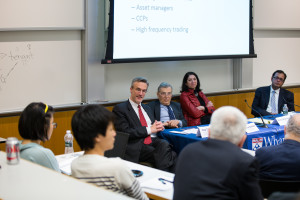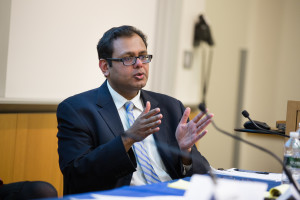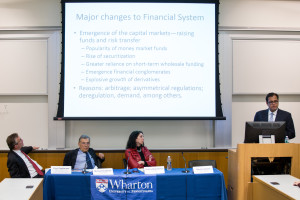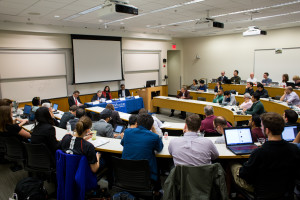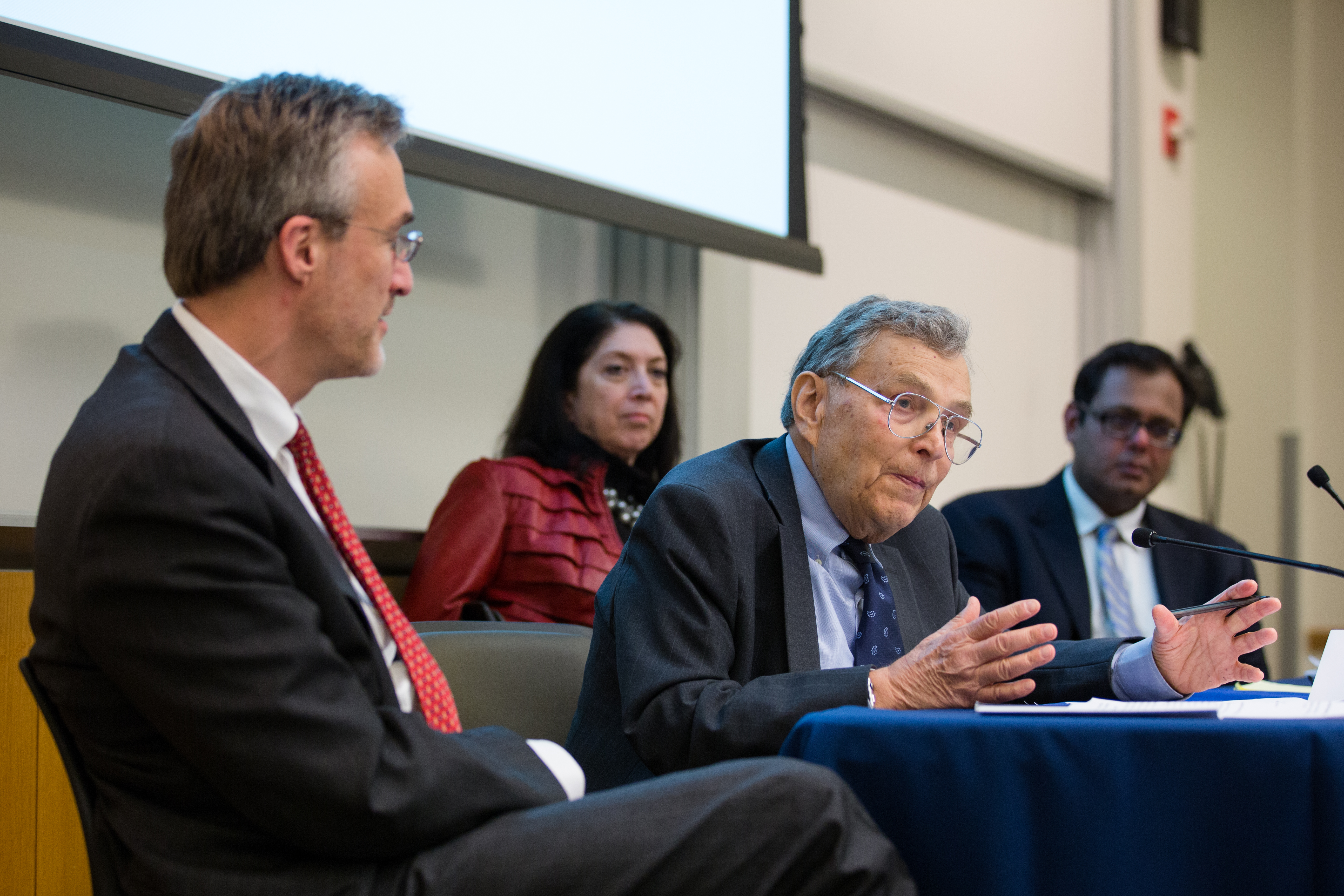
At Penn panel discussion, former Fed chair’s group urges further financial regulatory reform.
High speed trading and dark pools—two burgeoning forms of financial activity that remain mysterious to regulators and to market players—have continued to capture growing portions of U.S. securities markets in recent years, despite the legal reforms passed in the wake of the 2008 crisis. They are just two components of an evolving financial system whose intricate structure and complex risks have recently attracted heightened scrutiny.
The Volcker Alliance, an organization launched in 2013 by former Federal Reserve Board Chairman Paul Volcker, aims to bring about reforms that would empower policymakers to navigate the unknown, unregulated depths within the financial system. The Alliance released a report earlier this year, and recently several of the organization’s staff presented the report’s reform proposals at a seminar held at the Wharton School and sponsored by the Penn Program on Regulation.
Shelley Metzenbaum, senior advisor to the Alliance and formerly its founding president, began the seminar by outlining two of the Alliance’s broader goals: to analyze structural and systemic problems, and to build the human capital capacity within government to generate novel and effective solutions. Michael Bradfield, the Alliance’s general counsel (and formerly the general counsel of the Federal Reserve Board), argued that the current regulatory structure is outdated: the financial system has changed dramatically since its components were assembled, and these changes have embedded accumulated risks into the financial structure.
Bradfield said that the justification for the existence of six separate federal financial regulatory agencies had disappeared as very large, complex, and globally active firms have emerged to provide a very broad array of products and services that cross the previously clear and historic lines of activity of banking, securities, insurance, and commodities firms. Moreover, the markets for these often complex, opaque, and rapidly evolving products are dominated by non-bank providers of financial services that are now providing more than two-thirds of the credit available to non-financial firms, with this credit financed in large part by short term funding.
Bradfield stressed that although the financial system had changed, the federal financial agency structure had not changed. Despite the fundamental changes in financial system structure, the allocation of responsibilities among the federal financial regulatory agencies remains based on rigid historical grants of authority drawn along “functional” business lines such as banking, insurance, securities, and derivatives, and does not cover the shadow banks that are now providing so much of the credit presently available to non-financial firms. The consequence has been long delays or inaction on critical prudential supervisory matters and a failure to recognize the systemic instability inherent in the present bifurcated, Balkanized structure.
According to Bradfield, although Dodd-Frank included a large number of important changes to substantive rules and regulations (such as the Volcker Rule), it did not address the problems in the federal financial regulatory agency arrangements with its inherent tunnel-vision structure. The report makes suggestions for remedying critical issues arising from the inability of the present structure to deal with the systemic risks inherent in the present organizational structure of the federal financial regulatory agencies.
The Alliance’s report offers three central recommendations. First, Congress should enhance the authority and operational effectiveness of the Financial Stability Oversight Council (FSOC) and the Office of Financial Research (OFR), which would improve system oversight and surveillance. This reform would establish a limited membership FSOC subcommittee, insulated from outside political influence, with more robust authority to address risky activities and practices, and focused on the consideration of and decision on the designation of financial firms and financial activities as having a potential systemic impact on the U.S. economy and subject to regulation and supervision by the Federal Reserve.
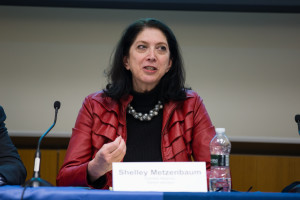
Shelley Metzenbaum outlines the goals of the Volcker Alliance.
Second, Congress should create a new prudential supervisory agency which would consolidate the supervisory responsibilities of the Federal Deposit Insurance Corporation, the Federal Reserve, the Office of the Comptroller of the Currency, as well as those of the U.S. Securities and Exchange Commission (SEC) and U.S. Commodity Futures Trading Commission (CFTC), into a new Prudential Supervisory Authority (PSA), and with prudential rulemaking assigned to the Federal Reserve initiated by recommendations of the PSA or self initiated by the Federal Reserve. The PSA would have its own Board of Directors, Chaired by the Vice Chairman for Supervision of the Federal Reserve.
Third, Congress should create a new agency that combines the SEC and the CFTC, eliminating an artificial bifurcation in securities and commodities regulation. This new agency would have responsibility for investor protection and market integrity.

The Volcker Alliance’s Michael Bradfield discusses opportunities for regulatory reform.
According to Bradfield, these three reforms would empower regulators to do a better job of identifying and mitigating systemic risk facilitated by a mandate to promote financial stability and the tools—especially a 360-degree view of the financial system as a whole—to carry out this objective. Consolidating prudential supervision into a single agency would allow for greater efficiency and timely decision making by the regulator and make regulatory compliance less costly for the regulated entities. The reforms would set out a framework for allowing the financial regulatory agency community to make a much more substantial and much more effective contribution of achieving and maintaining U.S. financial system stability while avoiding an excessive concentration of power that retains important checks and balances.
The panel also discussed some of the new research and goals the Alliance has developed since issuing its report. Gaurav Vasisht, director of financial regulation for the Alliance, argued that evolutions within the financial landscape have presented unique challenges to financial regulators that have so far gone effectively untreated. According to Vasisht, traditional banking activities historically adhered to traditional standards and practices, creating a path for a basic regulatory framework to settle. But over the last few decades, financial activity has changed, while the regulatory framework has stayed substantially the same.
New capital markets have emerged, pulling many banking-type activities away from traditional banks. For example, money market funds have become popular, securitization has expanded, large financial conglomerates have emerged and have shown greater reliance on unstable short-term wholesale funding to finance their activities, and the use of derivatives has exploded. Vasisht also noted more recent changes in the financial markets, such as the growth of the asset management industry, the increased risks concentrated in central clearing counterparties, and the emergence of high frequency trading in increasingly fragmented and opaque financial markets. Consequently, according to Vasisht, the market today is highly interconnected, opaque, leveraged, prone to the risk of runs, and insufficiently understood.
Vasisht added that difficulties exist with the “macroprudential perspective” among regulators, especially in the way that regulatory mandates and jurisdictions are too often misaligned. For example, the Federal Reserve has a financial stability mandate, but lacks reach deep enough into markets to cover many of the new, novel forms of financial activities that could be systemically risky, according to Vasisht. In contrast, the SEC does have the reach in important parts of the market, but no comparable clearly defined mandate for financial stability. And some agencies (including the SEC) are congressionally appropriated, meaning their funding, which has remained woefully inadequate, is subject to the whims of the political process. This, according to Vasisht, makes market regulation more challenging and only adds to regulatory uncertainty.
The Alliance’s staff stressed that reform should happen soon. Although they advocate for a non-partisan treatment of these issues, they suggested at the Penn panel session that the current political climate might mean that momentum will need to come from outside of Washington, DC, such as from academic institutions, trend-setting international bodies, or even young professionals entering the workforce who may be dedicated to improving the nation’s financial regulatory structure.

